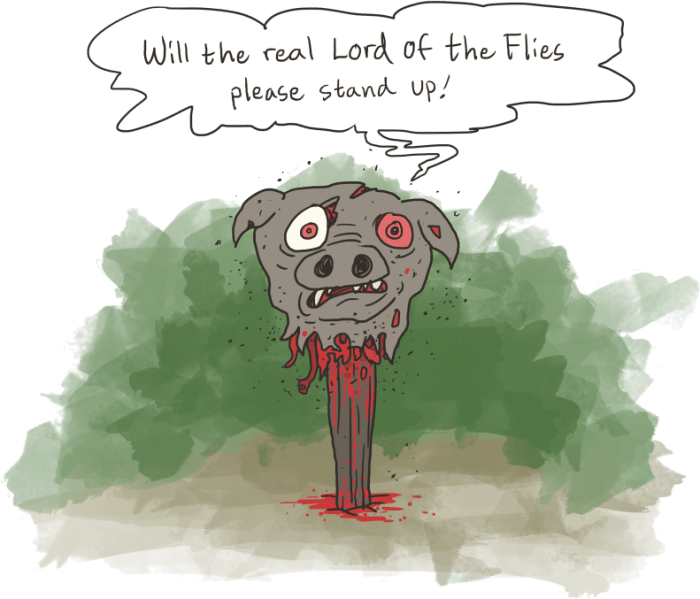Lord of the Flies Chapter 1-4 Summary: The Descent into Savagery is a captivating exploration of the human condition, examining the loss of innocence and the rise of savagery in the face of adversity. William Golding’s classic novel paints a vivid picture of a group of schoolboys stranded on a deserted island, forced to confront the darkness within themselves as they struggle to survive.
As the boys attempt to establish order and find rescue, they are divided into two factions, each representing a different approach to leadership and survival. Ralph, the elected leader, advocates for reason and cooperation, while Jack, the charismatic hunter, embraces violence and primal instincts.
The conflict between these two ideologies intensifies as the boys’ situation becomes increasingly desperate, leading to a tragic descent into chaos.
Initial Setting and Introduction of Characters
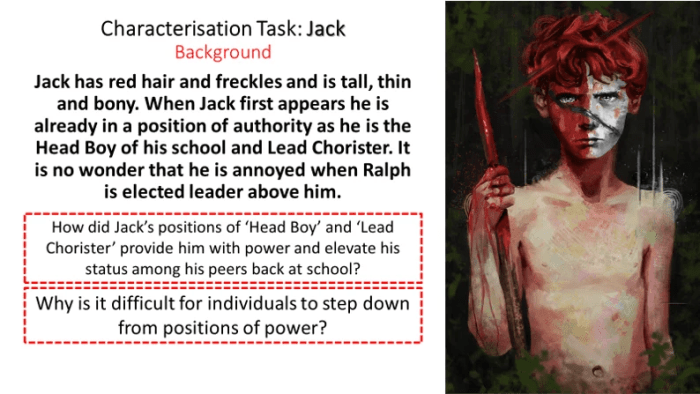
The initial setting of Lord of the Fliesis a tropical island in the Pacific Ocean. The island is lush and beautiful, with white sandy beaches, clear blue waters, and dense vegetation. However, it is also isolated and dangerous, with no sign of civilization for miles.
The main characters in the novel are a group of British schoolboys who are stranded on the island after their plane crashes. The boys range in age from six to twelve years old, and they come from a variety of backgrounds.
Some of the most important characters include Ralph, Piggy, Jack, Simon, and Roger.
Ralph is the elected leader of the boys. He is a natural leader who is fair and just. Piggy is Ralph’s best friend. He is intelligent and resourceful, but he is also overweight and asthmatic. Jack is Ralph’s rival.
He is a charismatic and ruthless leader who is more interested in power than in the well-being of the group. Simon is a quiet and thoughtful boy who is in touch with the spiritual side of life. Roger is a cruel and sadistic boy who enjoys hurting others.
The boys are stranded on the island after their plane is shot down during a nuclear war. The boys are initially excited to be free from the rules of adults, but they soon realize that they must create their own society in order to survive.
Formation of Societies and Leadership
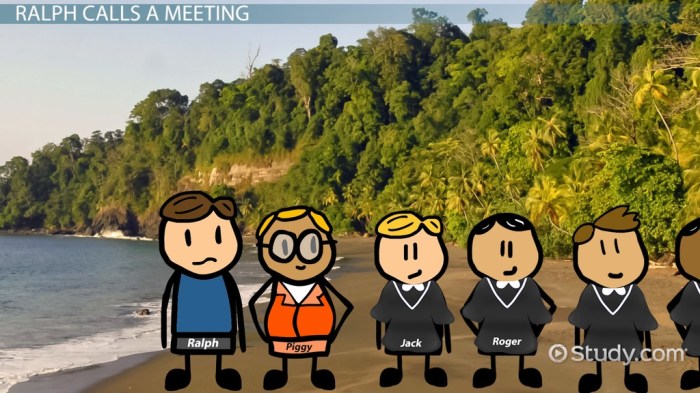
The boys on the island quickly form two distinct groups: the choir and the hunters. The choir, led by Ralph, is responsible for maintaining order and keeping the fire going. The hunters, led by Jack, are responsible for providing food.
As the groups evolve, tensions arise between them, reflecting the inherent conflicts between civilization and savagery.
Ralph and the Choir
Ralph, the elected leader of the group, represents reason and order. He believes in following rules and maintaining a sense of community. The choir, under his guidance, focuses on maintaining the fire, which symbolizes hope and civilization on the island.
Jack and the Hunters
Jack, Ralph’s rival, represents the primal instincts of savagery and violence. He prioritizes hunting and survival over rules and order. The hunters, under his leadership, become increasingly wild and aggressive, reflecting the dangers of unchecked power.
Conflicts and Tensions
As the two groups grow in size and influence, conflicts arise between them. Ralph and Jack clash over their different approaches to leadership and the island’s resources. The choir, representing civilization, becomes increasingly threatened by the hunters’ savagery, leading to a battle for dominance that will shape the island’s future.
The Loss of Innocence and Savagery
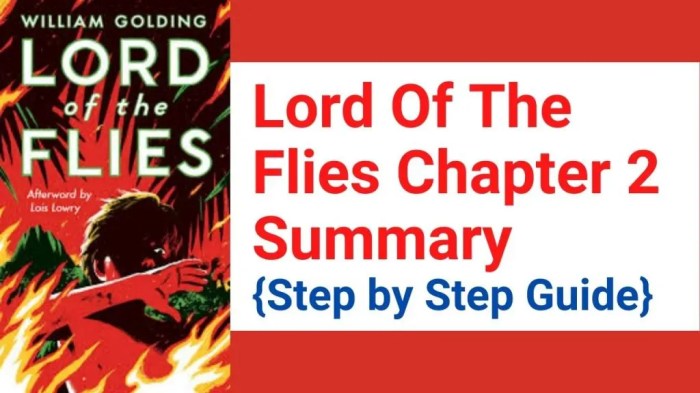
As the boys spend more time on the island, their initial excitement and sense of adventure gradually give way to fear, hunger, and isolation. These factors contribute to a gradual loss of innocence and a descent into savagery.
Initially, the boys are excited to be free from the constraints of adult supervision. They enjoy playing games, exploring the island, and creating their own rules. However, as time goes on, the boys’ fear of the unknown and their hunger for food begin to take hold.
They become increasingly suspicious of one another and start to form factions.
Isolation and Fear
The boys’ isolation on the island contributes to their loss of innocence. They are cut off from the civilizing influences of adults and the familiar routines of their daily lives. This isolation leads to a sense of fear and uncertainty, which in turn leads to aggression and violence.
For example, after the boys’ initial excitement wears off, they begin to worry about the lack of food and the possibility of being stranded on the island forever. This fear leads to a sense of paranoia and suspicion, which in turn leads to the formation of factions and the eventual outbreak of violence.
Hunger and Savagery
The boys’ hunger also contributes to their loss of innocence. As the boys’ hunger grows, they become increasingly desperate for food. This desperation leads to a breakdown in social order and a return to a more primitive state of existence.
For example, after the boys fail to catch any pigs, they begin to resort to cannibalism. This act of savagery is a clear indication of the boys’ loss of innocence and their descent into a more primitive state of existence.
The Search for Rescue and the Descent into Chaos: Lord Of The Flies Chapter 1-4 Summary
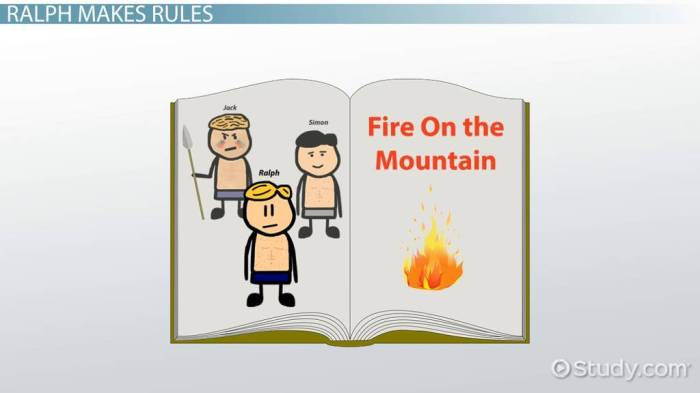
As the boys’ hope for rescue dwindled, their initial sense of excitement and adventure gradually gave way to despair and frustration. The lack of any sign of civilization or adult supervision further exacerbated the situation, leading to a progressive decline into chaos and savagery.
Attempts to Signal for Rescue
In their initial attempts to signal for rescue, the boys utilized the island’s resources, including a conch shell and a fire. However, their efforts proved futile as the conch was shattered and the fire burned out of control, symbolizing the boys’ inability to maintain order and cooperation.
The Descent into Chaos
As hope dwindled, the boys’ behavior became increasingly erratic and violent. The lack of adult guidance and the prolonged isolation on the island created a breeding ground for fear and mistrust, fostering a gradual descent into chaos.
The Tragic Death of Piggy, Lord of the flies chapter 1-4 summary
The culmination of the boys’ descent into savagery was the tragic death of Piggy, the voice of reason and order on the island. During a violent confrontation between Ralph and Jack’s factions, Piggy was brutally murdered by Roger, a member of Jack’s tribe.
Piggy’s death marked a turning point in the novel, symbolizing the complete loss of innocence and the triumph of savagery over civilization.
Helpful Answers
What is the main conflict in Lord of the Flies Chapter 1-4?
The main conflict is between Ralph, who represents reason and cooperation, and Jack, who represents violence and primal instincts.
How do the boys’ attempts to establish order and find rescue fail?
The boys’ attempts to establish order and find rescue fail due to their inability to overcome their own fears, selfishness, and lack of unity.
What is the significance of Piggy’s death?
Piggy’s death symbolizes the complete loss of innocence and the triumph of savagery over civilization.
